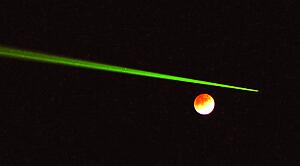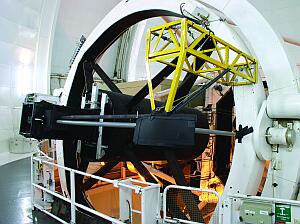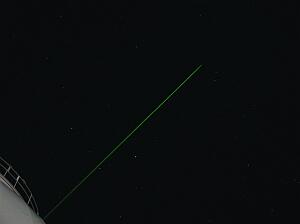Rayleigh Laser Guide Star Returns to the WHT
Tim Morris (Durham Univ.)
On
the nights of November 7th to 10th, a team from the University of Durham
Astronomical Instrumentation Group, together with colleagues from MPIA Heidelberg,
had a highly successful second run with the prototype laser guide star on
the WHT. Representing the completion of Phase B of the Durham experimental
Rayleigh Laser Guide Star (LGS) programme, the two teams were able to collect
simultaneous natural and laser guide star wavefront data.

|

|

|
| Figure 1 (left). The laser launch coincided
with a Lunar eclipse [ JPEG | TIFF ]. Figure 2 (middle). Laser launch telescope
mounted at the top of the WHT, behind the telescope secondary mirror
[ JPEG | TIFF ].
Figure 3 (right). The laser beam seen projected against the night sky above
the WHT [ JPEG | TIFF ].
|
3.5W of 523nm laser light was projected onto the sky using a custom- made
30cm launch telescope mounted behind WHT secondary. The laser itself was
installed in GRACE and the beam relayed to the launch telescope via enclosed
fold mirrors attached to the WHT structure.
A novel, focus-insensitive, wavefront sensor was utilised by the MPIA team
to observe the LGS return in GHRIL. Early analysis of the collected data
indicates that the focussed spot size at 4.5km was approximately 2×4
arcseconds in seeing of 1 arcsecond, the spot elongation being due to the
ellipticity of the laser output itself.
Reduction of the collected data is underway. The laser operated reliably
over the 3.5 nights with no technical downtime. This development work indicates
that the proposed 20W common-user Rayleigh laser guide star system for NAOMI
can be implemented with confidence.
The assistance and support provided by ING, without which the trial would
not have been possible, is gratefully acknowledged.
¤
Email contact: Tim
Morris (
t.j.morris@durham.ac.uk)





